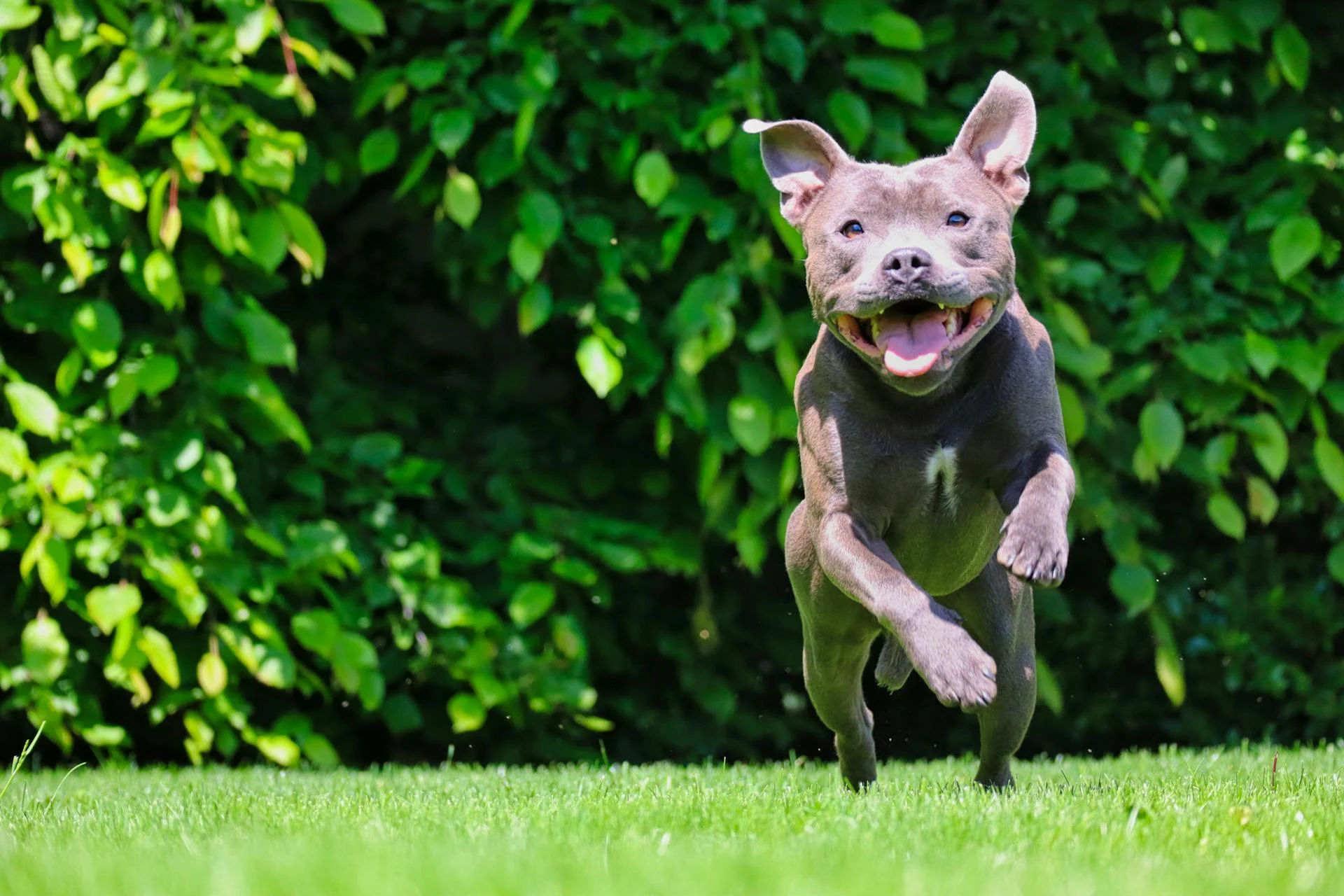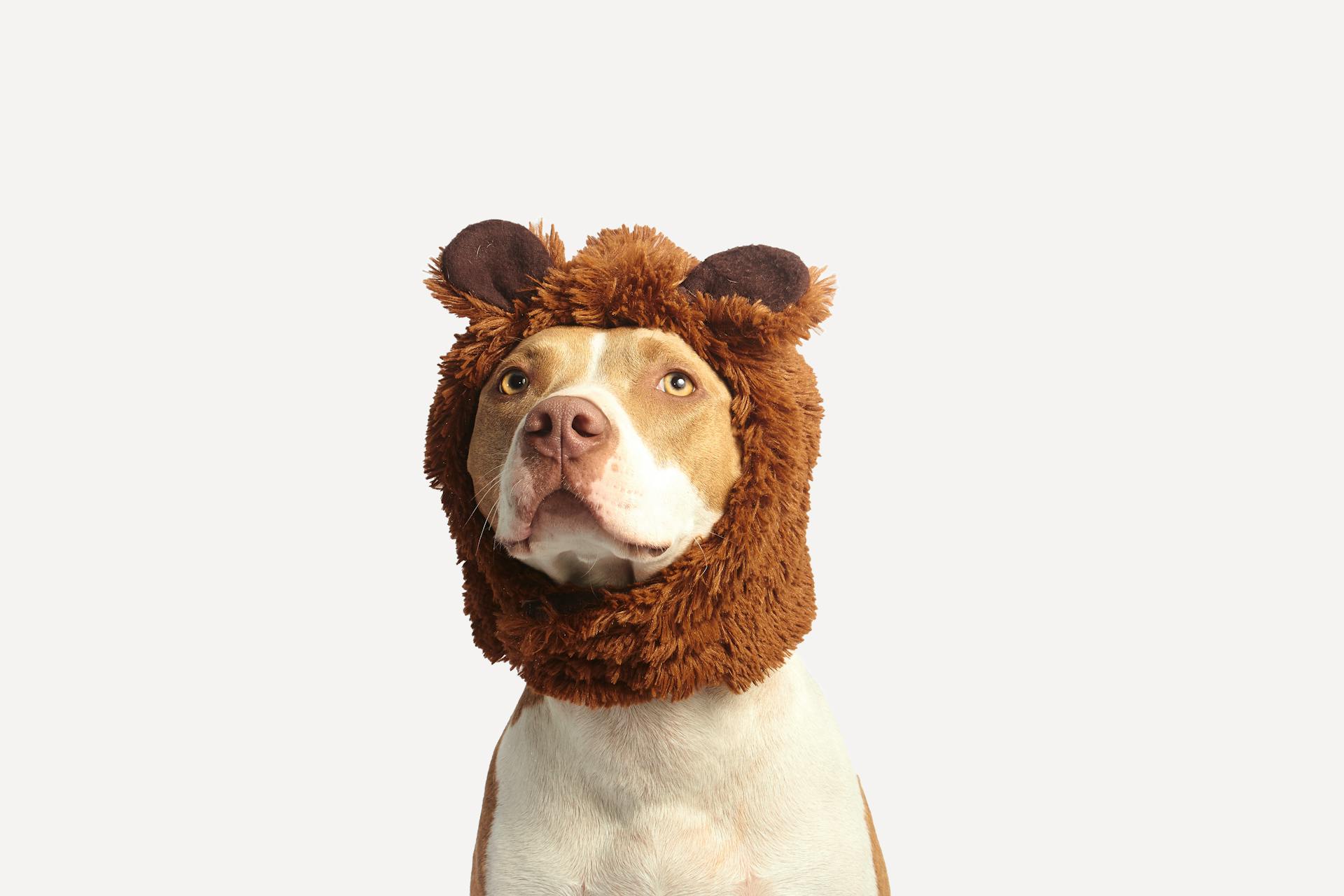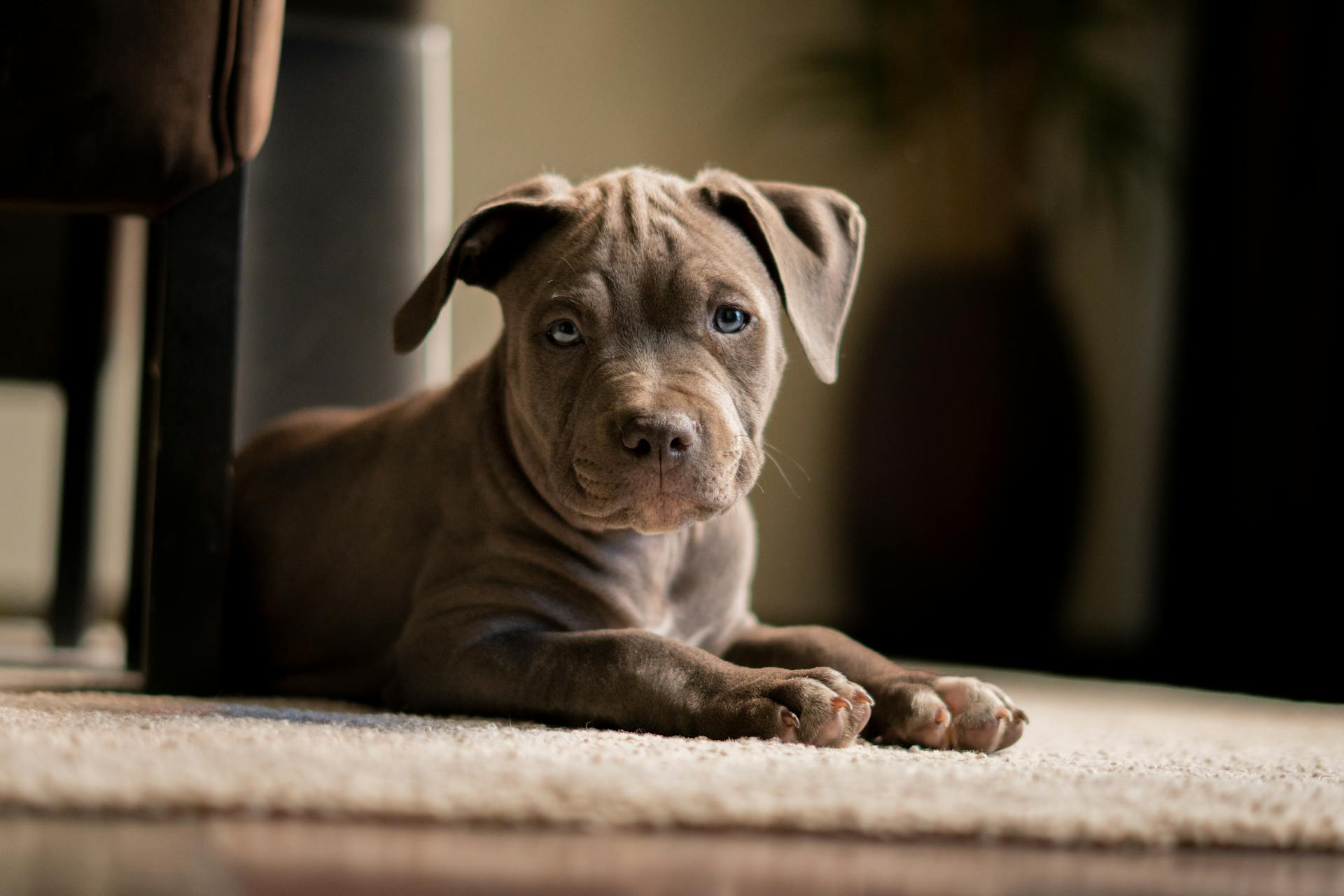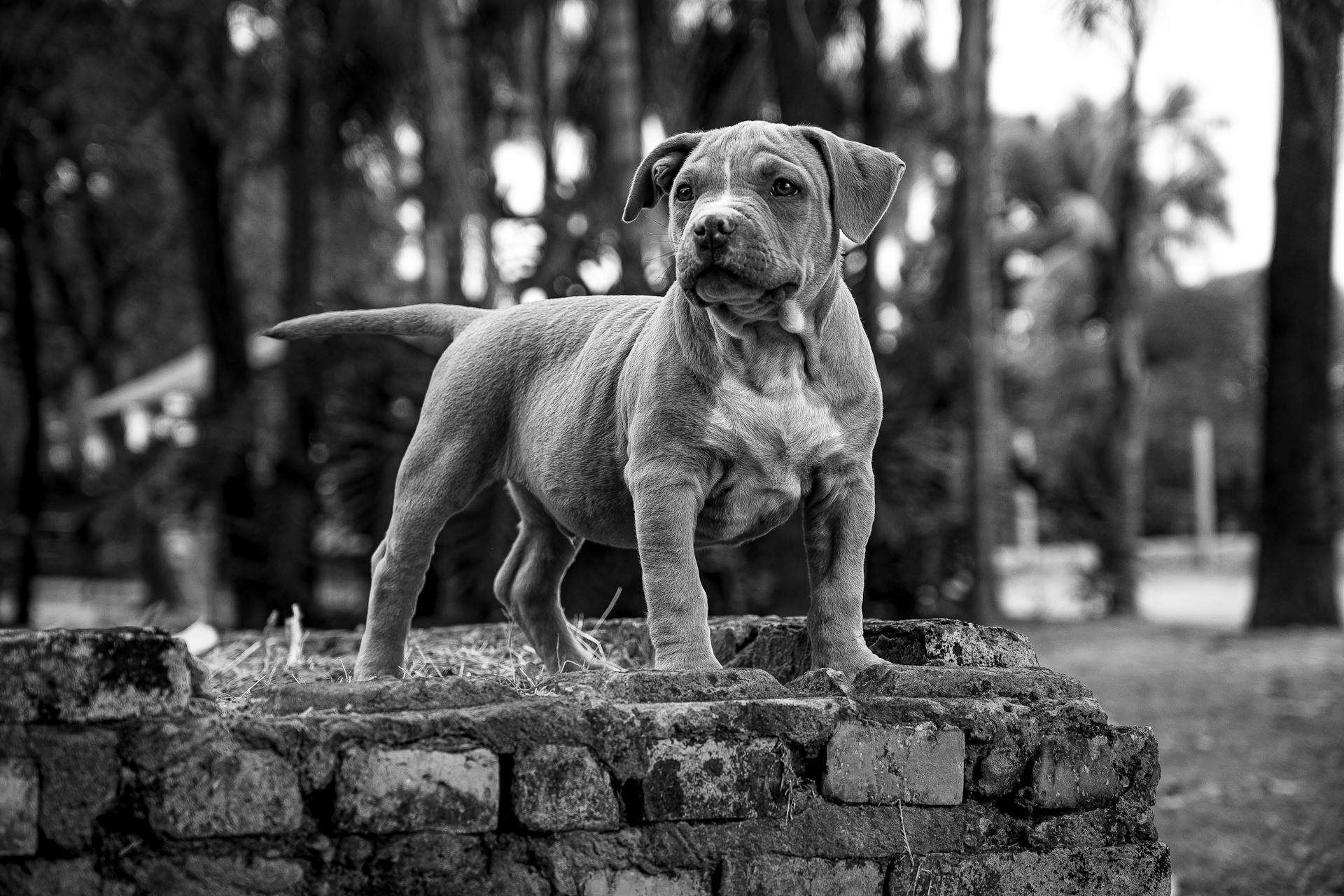
Owning a Bully Pit dog can be a wonderful experience, but it's essential to understand the breed's unique characteristics and needs.
The Bully Pit is a cross between an American Pitbull Terrier and a Bulldog, resulting in a strong and affectionate companion.
They require regular exercise to stay happy and healthy, with at least 30 minutes of physical activity daily.
With proper training and socialization, Bully Pit dogs can thrive in various living situations, including apartments and homes with small yards.
Breed Information
The Bullypit breed has a rich history, but it's not as long as you might think. The American Bulldog, one of its parent breeds, originated in the United States in the 1700s.
The American Bulldog was originally bred to wrangle cattle and bait bulls, but after bull baiting was outlawed in 1835, some breeders tried to use them as fighting dogs, although this was unsuccessful.
The Bullypit is likely to have the same characteristics as its parent breeds, such as being incredibly fearless and loyal. They make great guard dogs because of these traits.
All American Bulldogs were bred from Johnson, Baily, Scott, or Williamson strains. The American Pit Bull Terrier, the other parent breed, was bred in the United Kingdom in the 19th century by crossing a Bulldog with a Terrier.
The American Pit Bull Terrier was originally used in fighting and bull baiting, which has unfortunately led to a bad reputation as an aggressive breed. However, this is not true, and they are normally not aggressive with humans or other pets unless they are abused or treated with aggression.
Curious to learn more? Check out: Terriers Originally Bred in Yorkshire
Temperament and Behavior
The Bullypit is a gentle and cuddly breed with their family, but they can be intimidating to strangers. They thrive on attention and affection from their loved ones.
Socialization is key when it comes to getting along with other pets in the household. If done properly, they'll be just as happy to play with the cat as they are to chase squirrels outside.
Consistency is crucial when training a Bullypit. They respond well to positive reinforcement and clear boundaries, but aggressive punishment can have the opposite effect.
For your interest: What to Feed Dogs without Dog Food
Temperament
The Bullypit is a gentle and cuddly breed with their family, making them a loving companion.
They are easy to train as long as they know who the boss is, which is crucial for establishing a harmonious household.
Consistency is key when training a Bullypit, and using aggressive punishment can have the opposite effect, making them aggressive in return.
Socialization is essential when they're young to ensure they get along with other pets in the household.
With proper training and socialization, a Bullypit will be a loyal and loving member of the family.
A different take: Bull Terrier Aggression
Temperament and Behavior
The Bullypit is a social breed that needs daily walks to maintain its socialization skills. These walks should be at least an hour to 90 minutes long.
Bullypits need to stay active, so they can easily get bored and destructive if they don't get enough exercise. This can lead to unwanted chewing on furniture or other household items.
Daily walks on a leash are a great way to keep your Bullypit active, but they're not a dog-friendly breed, so it's best to stick with leashed walks.
Training
The Bullypit's temperament is a unique blend of gentle and fierce, but with proper training and socialization, they can thrive as loving family pets. They are extremely intelligent, but some types can be stubborn.
To get the best out of your Bullypit, you need to establish yourself as the pack leader, and they'll follow your lead. Consistency is key when training a Bullypit, and harsh punishment can make them aggressive.
Bullypits need a lot of early training and socialization, especially if you plan to have them around other people and animals regularly. This will help them develop good behavior and reduce the risk of aggression.
With their playful nature, it's not hard to get a Bullypit to exercise, but you may need to coax them to get enough physical activity. Daily walks on a leash are an excellent way to maintain their socialization skills and help them burn off extra calories.
Health and Care
Health and Care is a crucial aspect of owning a Bullypit. Regular exercise is essential to their wellbeing, so make sure to provide plenty of physical activity, such as playing with toys inside or outside, and letting them run.
Some types of pit bulls are prone to health issues that can be very costly in the long run, so it's essential to be aware of the potential risks. Hip dysplasia is a common issue that can lead to extensive discomfort and surgery, which can run into thousands of dollars.
To minimize the risk of genetic defects, it's recommended to buy from reputable breeders who screen for common issues. Pre-health screenings for the hips and elbows by the Orthopedic Foundation for Animals can also help identify potential problems early on.
Here are some common health issues that can affect Bullypits:
- Cataracts
- Demodectic mange
- Skinfold dermatitis
- Hip and elbow dysplasia
- Luxating patella
- Cardiac issues
Grooming is relatively easy and straightforward, but it's still essential to keep up with nail trimming, especially if your pup isn't overly active. Regular brushing can also help control shedding and reduce the amount of hair you'll find in your house.
Breed Maintenance
Breed Maintenance is a breeze with Bullypits. They have short hair, so brushing only needs to be done once or twice a week with a soft bristle brush.
Their short hair also means they don't need to be bathed often, unless absolutely necessary. Over-bathing can lead to dry skin, so it's best to err on the side of caution.
Regular ear cleaning is a must, so take the time to check for redness, wax buildup, and ear mites once a week. It's a quick and easy process that'll keep your Bullypit healthy.
Don't forget to brush your Bullypit's teeth at least once or twice a week with dog-specific toothpaste. This will help keep their teeth clean and healthy.
Trimming their nails is also essential, especially if they're not super active. Walking on sidewalks will wear them down some, but it's better to get them used to nail trimming as a puppy.
For your interest: Black Mouth Cur Teeth
Health Problems
Pit bulls are prone to certain health issues that can be costly and uncomfortable for them. Hip dysplasia is a common problem, which can lead to extensive discomfort and surgery that can run into thousands of dollars.

Some Pit bulls also experience heart issues due to improper breeding. These issues can be serious and require expensive treatment.
The Bullypit is at risk for a variety of health problems, particularly those affecting the skeletal and respiratory systems. Pre-health screenings for the hips and elbows can help identify potential issues early on.
Here are some common health issues that can affect Pit bulls and Bullypits:
- Cataracts
- Demodectic mange
- Skinfold dermatitis
- Hip and elbow dysplasia
- Luxating patella
- Cardiac issues
Food & Diet
Bullypits aren't overly active, so it's essential to monitor their caloric intake to prevent weight gain and related health issues like diabetes.
Regularly scheduled meals are a great way to manage their food consumption and match it to their activity levels.
Setting specific meal times instead of free-feeding kibble is a more manageable task, especially for larger breeds like the Bullypit.
They'll need relatively less food than smaller dogs with faster metabolisms.
Monitoring their weight is crucial, as this hybrid is prone to obesity, and adjusting their diet accordingly will help prevent weight-related health issues.
Owning a Pit Bull
You'll want to consider the long work hours and how they'll affect your Pit Bull's self-confidence and mental state, as crate confinement for 8-10 hours a day can be detrimental.
Leaving your Pit Bull alone for extended periods may lead to separation anxiety, so it's essential to find ways to keep them engaged and stimulated.
A Pit Bull mix, like a Bullypit, can make a wonderful pet, but they do require regular exercise and mental stimulation to prevent destructive behavior.
If you're bringing a new Pit Bull puppy home, be prepared for constant biting, especially at 9 weeks old, as they're still learning what's acceptable to chew on.
To minimize shedding and prevent unpleasant odors, regular bathing may not be enough, as the smell can return even after a bath.
Keep in mind that owning a Pit Bull comes with a stigma, and many people view them as ferocious and dangerous animals, which can be a barrier in social situations.
It's essential to understand this stigma and be prepared to educate others about the loving and gentle nature of your Pit Bull.
Owner Experiences
Owning a Pit Bull can be a rewarding experience, but it's normal to have concerns about their behavior and well-being. Leaving a Pit Bull in a crate for extended periods can indeed hurt their self-confidence and mental state, so consider investing in a dog walker or asking a neighbor for help.
Many Pit Bull owners have reported that their dogs are loving companions and can thrive in a family environment. However, some Pit Bulls may have a strong guarding instinct due to their breed history.
A 9-week-old puppy's biting is a normal phase of development, but it's essential to teach them gentle play and boundaries. Consistency and positive reinforcement can help curb this behavior.
Some Pit Bulls can be prone to body odor, which may return even after a bath. Regular grooming and using a de-shedding tool can help reduce shedding and prevent this issue.
A Pit Bull mix, like the Bullypit, can make a wonderful pet for the right owner. With proper training and socialization, they can become confident and well-adjusted companions.
Considerations Before Owning a Breed
Before adopting a Pit Bull, you'll want to consider the stigma surrounding these breeds. Many people view them as ferocious and dangerous animals, no matter how inaccurate that description is.
You'll need to understand that this stigma can be a barrier in your neighborhood or at the dog park.
It's essential to research the breed and understand its characteristics, temperament, and needs.
Owning a Pit Bull requires a commitment to training and socialization to help your pet interact with others in a positive way.
Legalities and Insurance
Owning a Pit Bull comes with its fair share of challenges, and one of the biggest ones is navigating the legalities and insurance requirements.
Some cities and towns deem Pit Bulls illegal to own due to their reputation for being aggressive, and breed-specific legislation is a real concern.
If you rent, your landlord may have a stipulation against owning a Pit Bull, so it's essential to check your lease agreement before bringing one home.
Insurance companies often refuse to underwrite policies for homes with Pit Bulls, so make sure you do your research and understand what legalities may apply in your area.
Consider reading: Dog Liability Insurance for Pit Bulls
Mixed Breeds
If you're considering getting a Pitbull, you might be interested in the many mixed breeds that combine the best of the Pitbull with another popular breed.
Purebred Pitbulls are often mixed with other popular dog breeds, resulting in some amazing hybrid Pitbulls.
Some of the most popular hybrid Pitbulls include mixes with other breeds that are known for their strength and loyalty.
These mixed breeds are often considered to be Bullies, but it's up for debate whether they truly fit the bill.
Pitbull crossbreeds are bred with other dogs that share specific characteristics, making them a great option for people who want a unique pet.
For another approach, see: Cardigan Welsh Corgi Mixed Breed
Almost Extinct
The American Bulldog's close relative, the American Pit Bull Terrier, has a similar history of near-extinction. By the end of World War II, the breed was almost extinct.
John D. Johnson, a returning war veteran, along with Alan Scott and several other breeders, worked tirelessly to re-establish the breed. Their efforts resulted in distinct bloodlines, including the Johnson type and the Scott type.
The Johnson type has a bulkier, heavier frame and large head, while the Scott type is more athletic. Most modern American Pit Bull Terriers are a hybrid of these two original lines.
Breeding efforts like these demonstrate the dedication and perseverance required to save a breed from extinction.
A different take: American Bulldog Puppies Johnson Breed
Types and Variations
There are different types of Pitbulls, each with their own unique characteristics.
Some Pitbulls are mixed breeds, often created by combining the popular Pitbull with other popular dog breeds.
People love the Pitbull so much that they tend to breed it with other dogs with specific characteristics, resulting in a variety of crossbreeds.
Explore further: English Bull Terrier Facts
Types of Pit Bulls
The Blue Nose Pitbull is a rare breed with a unique appearance, characterized by a black or gray nose due to a double recessive gene. They typically range in size from 18 to 21 inches tall and weigh between 30 and 60 pounds.
They have a great temperament and are good with other animals when growing up with them. However, they can be intelligent but stubborn, making them a challenge to train.
The Bullypit breed is a hybrid of the American Bulldog and the American Pit Bull Terrier, two breeds with rich histories. The American Bulldog originated in the United States in the 1700s, while the American Pit Bull Terrier has been around since the 19th century.
The Pitweiler, or Pitbull Rottweiler mix, is a large and muscular dog that stands 20 to 23 inches tall and weighs between 65 to 100 pounds. They require vigorous activity and training to keep them happy and healthy.
The Pitweiler is also prone to certain health issues, including hip and elbow dysplasia, cerebellar abiotrophy, demodectic mange, and subaortic stenosis, a heart issue that needs monitoring.
Standard
The Standard American Bully is a breed that's known for its muscular build and confident attitude. They typically stand between 16 and 20 inches tall at the withers.
Their gait is effortless and powerful, with a proud and alert demeanor. The American Bully moves with a sense of freedom and vigor, with each leg moving in the same plane as the others.
Their backline remains level, with only slight flexing. This breed is not penalized for being heavily muscled, which is a unique characteristic of the Standard American Bully.
Their legs don't cross or interfere with each other, and they move on the same plane with minimal convergence. This makes for a smooth and efficient gait.
The Standard American Bully's movement is often described as unrestrained and free, with powerful drive off the rear.
Red Nose
The Red Nose Pitbull is a unique variation with reddish-pink noses that match their coats, which are typically brown, fawn, or red in color.
They stand between 14 to 24 inches tall and weigh between 22 and 78 pounds.
Red Nose Pitbulls are prone to cerebellar abiotrophy, which can lead to balance and coordination issues and hip dysplasia.
They are generally gentle, affectionate dogs that are eager to please and very intelligent.
These types of pits should go to families with older children because of their strength and size.
Red Nose Pitbulls live to be between 8 and 15 years old.
Frequently Asked Questions
What two dogs make a bully Pitbull?
The American Bully is a cross between the American Pit Bull Terrier and the American Staffordshire Terrier, among other breeds. This unique mix of breeds gives the American Bully its distinctive characteristics and traits.
Featured Images: pexels.com


